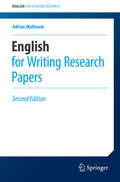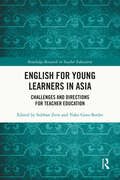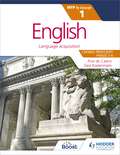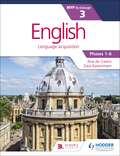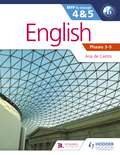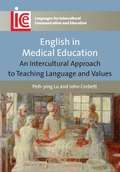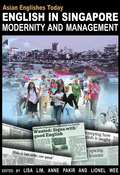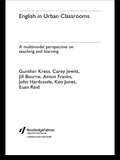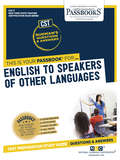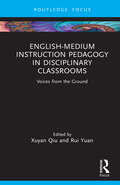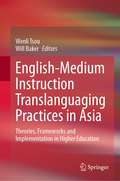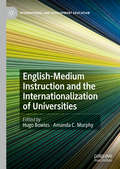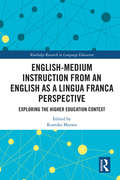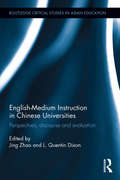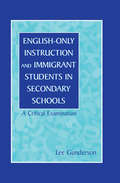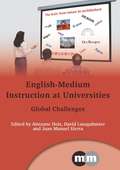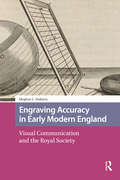- Table View
- List View
English for Writing Research Papers, 2nd Edition
by Adrian WallworkPublishing your research in an international journal is key to your success in academia. This guide is based on a study of over 1000 manuscripts and reviewers' reports revealing why papers written by non-native researchers are often rejected due to problems with English usage and poor structure and content. <P><P> With easy-to-follow rules and tips, and examples taken from published and unpublished papers, you will learn how to:<P> * prepare and structure a manuscript<P> * increase readability and reduce the number of mistakes you make in English by writing concisely, with no redundancy and no ambiguity<P> * write a title and an abstract that will attract attention and be read<P> * decide what to include in the various parts of the paper (Introduction, Methodology, Discussion etc)<P> * highlight your claims and contribution<P> * avoid plagiarism<P> * discuss the limitations of your research<P> * choose the correct tenses and style<P> * satisfy the requirements of editors and reviewers<P> This new edition contains over 40% new material, including two new chapters, stimulating factoids, and discussion points both for self-study and in-class use.
English for Young Learners in Asia: Challenges and Directions for Teacher Education (Routledge Research in Teacher Education)
by Subhan ZeinIn the first book to concentrate on teacher education for English for young learners (EYL) teachers in Asia, Zein and Butler offer a comprehensive coverage of teacher education by addressing various issues and recent developments such as programme evaluation, knowledge base, practicum, classroom discourse, needs analysis, and policy on teacher education. The world’s rapidly changing political, social, economic, and educational landscapes in the 21st century have been distinctively characterized by an increasing number of children who are learning English globally at younger ages. This book tackles the challenges and complexities surrounding teacher education by examining the policies and practices of primary English language teacher education in a variety of educational contexts, namely Bangladesh, China, Indonesia, Japan, Kazakhstan, Thailand, and South Korea. Using a variety of data collection methods like interviews, reflective journals, and questionnaires, the content delves into the different strategies and initiatives that have been implemented or proposed to improve teacher education. A vital read for academics and students in the fields of early language learning, Teaching English to Speakers of Other Languages (TESOL), Applied Linguistics, Educational Linguistics, English Language Education, and comparative education studies, as well as teacher educators aiming to advance the teaching of English in Asia and beyond.
English for the IB MYP 1
by Zara Kaiserimam Ana de Castro Stephanie BarrusExam Board: MYPLevel: IBSubject: EnglishFirst Teaching: September 2016First Exam: June 2017Develop your skills to become an inquiring learner; ensure you navigate the MYP framework with confidence using a concept-driven and assessment-focused approach to English presented in global contexts.- Develop conceptual understanding with key MYP concepts and related concepts at the heart of each chapter.- Learn by asking questions with a statement of inquiry in each chapter. - Prepare for every aspect of assessment using support and tasks designed by experienced educators.- Understand how to extend your learning through research projects and interdisciplinary opportunities.
English for the IB MYP 1
by Zara Kaiserimam Ana de CastroExam Board: MYPLevel: IBSubject: EnglishFirst Teaching: September 2016First Exam: June 2017Develop your skills to become an inquiring learner; ensure you navigate the MYP framework with confidence using a concept-driven and assessment-focused approach to English presented in global contexts.- Develop conceptual understanding with key MYP concepts and related concepts at the heart of each chapter.- Learn by asking questions with a statement of inquiry in each chapter. - Prepare for every aspect of assessment using support and tasks designed by experienced educators.- Understand how to extend your learning through research projects and interdisciplinary opportunities.
English for the IB MYP 2
by Zara Kaiserimam Ana de Castro Stephanie BarrusA concept-driven and assessment-focused approach to English language acquisition teaching and learning.- Approaches each chapter with statements of inquiry framed by key and related concepts, set in a global context- Supports every aspect of assessment using tasks designed by an experienced MYP educator- Differentiates and extends learning with research projects and interdisciplinary opportunities- Applies global contexts in meaningful ways to offer an MYP English programme with an internationally-minded perspective
English for the IB MYP 2
by Zara Kaiserimam Ana de CastroA concept-driven and assessment-focused approach to English language acquisition teaching and learning.- Approaches each chapter with statements of inquiry framed by key and related concepts, set in a global context- Supports every aspect of assessment using tasks designed by an experienced MYP educator- Differentiates and extends learning with research projects and interdisciplinary opportunities- Applies global contexts in meaningful ways to offer an MYP English programme with an internationally-minded perspective
English for the IB MYP 3
by Zara Kaiserimam Ana de Castro Stephanie BarrusExam board: International BaccalaureateLevel: MYPSubject: EnglishFirst teaching: September 2014First exams: Summer 2016Develop your skills to become an inquiring learner; ensure you navigate the MYP framework with confidence using a concept-driven and assessment-focused approach to English presented in global contexts.- Develop conceptual understanding with key MYP concepts and related concepts at the heart of each chapter.- Learn by asking questions with a statement of inquiry in each chapter. - Prepare for every aspect of assessment using support and tasks designed by experienced educators.- Understand how to extend your learning through research projects and interdisciplinary opportunities.
English for the IB MYP 3
by Zara Kaiserimam Ana de CastroExam board: International BaccalaureateLevel: MYPSubject: EnglishFirst teaching: September 2014First exams: Summer 2016Develop your skills to become an inquiring learner; ensure you navigate the MYP framework with confidence using a concept-driven and assessment-focused approach to English presented in global contexts.- Develop conceptual understanding with key MYP concepts and related concepts at the heart of each chapter.- Learn by asking questions with a statement of inquiry in each chapter. - Prepare for every aspect of assessment using support and tasks designed by experienced educators.- Understand how to extend your learning through research projects and interdisciplinary opportunities.
English for the IB MYP 4 & 5: MYP by Concept (MYP By Concept)
by Ana de CastroWe are working with the IBO to gain endorsement for the MYP by Concept series.Drive meaningful inquiry for the new framework through a unique concept driven narrative.- Supports every aspect of assessment with opportunities that use the criteria- Gives you easy ways to differentiate and extend learning- Provides a meaningful approach by integrating the inquiry statement in a global context- Develops critical-thinking skills with activities and summative sections rooted in the ATL frameworkAlso coming soon are Teaching and Learning Resources and eTextbooks via Dynamic Learning, our complete digital solution.
English for the IB MYP 4 & 5: MYP by Concept (MYP By Concept)
by Ana de CastroWe are working with the IBO to gain endorsement for the MYP by Concept series.Drive meaningful inquiry for the new framework through a unique concept driven narrative.- Supports every aspect of assessment with opportunities that use the criteria- Gives you easy ways to differentiate and extend learning- Provides a meaningful approach by integrating the inquiry statement in a global context- Develops critical-thinking skills with activities and summative sections rooted in the ATL frameworkAlso coming soon are Teaching and Learning Resources and eTextbooks via Dynamic Learning, our complete digital solution.
English in Medical Education
by John Corbett Peih-Ying LuThis book addresses recent developments in medical and language education. In both fields, there have been methodological shifts towards 'task-based' and 'problem-based learning'. In addition, both fields have broadened their focus on clinical expertise and linguistic skills to address issues of cultural competence. English in Medical Education responds to these changes by re-imagining the language classroom in medical settings as an arena for the exploration of values and professional identity. The chapters cover topics such as the nature of cultural competence; how to understand spoken discourse in a range of medical settings; the use of tasks and problems in language education for medics; the development of critical skills and the use of literature and visual media in language education for doctors. It will interest everyone teaching English for Medical Purposes.
English in Singapore
by Lisa Lim Anne Pakir Lionel WeeEnglish in Singapore provides an up-to-date, detailed and comprehensive investigation into the various issues surrounding the sociolinguistics of English in Singapore. Rather than attempting to cover the usual topics in an overview of a variety of English in a particular country, the essays in this volume are important for identifying some of the most significant issues pertaining to the state and status of English in Singapore in modern times, and for doing so in a treatment that involves a critical evaluation of work in the field and new and thought-provoking angles for reviewing such issues in the context of Singapore in the twenty-first century. The contributions address the historical trajectory of English (past, present and possible future), its position in relation to language policy and multiculturalism, the relationship between the standard and colloquial varieties, and how English can and should be taught. This book is thus essential reading for scholars and students concerned with how the dynamics of the English language are played out and managed in a modern society such as Singapore. It will also interest readers who have a more general interest in Asian studies, the sociology of language, and World Englishes.
English in Urban Classrooms: A Multimodal Perspective on Teaching and Learning
by Ken Jones Gunther Kress Jill Bourne Carey Jewitt John Hardcastle Euan Reid Anton FranksEnglish in Urban Classrooms is a ground-breaking text that spans a range of issues central to school English today. It extends not only to the spoken and written language of classrooms, but also to other modes of representation and communication that are important in English teaching. This includes image, gesture, gaze, movement and spatial organisation. The team of experienced and expert authors collectively examine how English is shaped by policy, institutions and the social relations of the classroom. By connecting issues of policy and social context, the book provides a detailed account of factors such as: the characteristics of urban multi-cultural schools teacher formation and tradition the ethos of school English departments the institutional changes that have shaped school English in urban classrooms students' experiences of learning. This book offers a fascinating and enlightening read, not only to those involved in English teaching, but also to educational researchers, policymakers, linguists and those interested in semiotics and multi-modality.
English to Speakers of Other Languages: Passbooks Study Guide (New York State Teacher Certification Examination Series (NYSTCE))
by National Learning CorporationThe New York State Teacher Certification Exams (NYSTCE) are required for all candidates seeking licensure in the State. The NYSTCE series consists of many different tests assessing skills and abilities necessary for teachers. The Passbook® for the Content Specialty Test for English to Speakers of Other Languagesprovides hundreds of multiple-choice questions in the areas that will likely be covered on your upcoming certification exam, including but not limited to:understanding language and linguistic concepts; methods and techniques for developing reading, writing and speaking skills; and other related areas.
English, 6th Class - Andhra Pradesh Board
by ApscertThis is the prescribed text book for 6th class students for the subject of English language in the state of Andhra Pradesh.
English-Medium Instruction Pedagogy in Disciplinary Classrooms: Voices from the Ground (Routledge Focus on English-Medium Instruction in Higher Education)
by Rui Yuan Xuyan QiuThis book addresses the challenges often encountered by English-medium instruction (EMI) teachers when teaching content subject knowledge in English, by exploring effective EMI teaching methods tailored to diverse classroom needs.The eight chapters delve into EMI pedagogies across various disciplines, such as computing, design, history, applied linguistics, in different regions including Spain, Hong Kong, Macau, and Japan. By examining actual classroom practices and the perspectives of both teachers and students, these chapters offer practical strategies for building disciplinary knowledge in EMI classrooms. They also explore the benefits and rationale of using translanguaging practices, incorporating students’ first language, and integrating technology into EMI teaching. Additionally, the book highlights the use of intercultural humour to enhance communication and learner engagement in multicultural classrooms. The authors not only provide insights into current practices but also discuss future research directions and recommendations for EMI teacher education. They emphasize the importance of considering specific disciplinary characteristics and learner needs, advocating for customized teacher training and development opportunities for EMI teachers.Written for scholars, education professionals, practitioners, and postgraduate students interested in EMI pedagogy in higher education, this volume is also relevant to courses pertaining to language policy, language education, and curriculum innovation in multicultural contexts.
English-Medium Instruction Translanguaging Practices in Asia: Theories, Frameworks and Implementation in Higher Education
by Wenli Tsou Will BakerThis book examines translanguaging pedagogy in Asia’s English-medium instruction (EMI) higher education. It presents an overview of concepts and common issues, and case studies from specific contexts in Asia. The book first interrogates macro-level English-medium instruction policies and implementation from English as a lingua franca (ELF) perspectives. Following this, implications of English as a lingua franca on English-medium instruction pedagogy will be explored, with a theoretical framework of 'translanguaging pedagogy' developed. The book concludes with a discussion on translanguaging and how the concept contributes to English-medium instruction in Asia. Through the book, the content focuses on the specificity of each Asian English-medium instruction context from a translanguaging lens. English-medium instruction policies and translingual practices from China, Japan, Taiwan, Thailand, and Vietnam are explored, and opportunities and challenges related to translanguaging pedagogy in Asian English-medium instruction classrooms are examined.
English-Medium Instruction and the Internationalization of Universities (International and Development Education)
by Hugo Bowles Amanda C. MurphyThis edited book examines English-Medium Instruction (EMI) language policy and practice in higher education around the world, highlighting how English language usage affects the internationalization of universities, the way that disciplines are taught and learned, and questioning whether internationalization through EMI achieves the values of global citizenship and inclusivity/diversity to which it aspires. Written by experts in the field, the book includes data-based research from universities around the globe, with three chapters on Asia and the Far East (Malaysia, Japan and China), four on Europe (Denmark, the Netherlands and Italy) and one each on Africa (Ethiopia) and Central America (Mexico). Sources include policy documents, questionnaire surveys, focus groups and semi-structured interviews involving university policymakers, lecturers, students, and administrative staff. This book will be of interest to students and scholars of language and education policy, internationalization and applied linguistics, particularly English-Medium Instruction (EMI), academic English and English as a Lingua Franca (ELF).
English-Medium Instruction from an English as a Lingua Franca Perspective: Exploring the Higher Education Context (Routledge Research in Language Education)
by Kumiko MurataEnglish is increasingly used as a lingua franca (ELF) in communicative situations the world over with the acceleration of globalisation. This is in line with the increased introduction of English-medium instruction (EMI) to higher education institutions in many parts of the world to further promote both students’ and faculty’s mobility to make them competitive and employable in the globalised world, and to make their institutions more attractive and reputable. EMI and ELF, however, are rarely explicitly investigated together despite the fact that the spread of EMI cannot be separated from that of ELF. This volume tackles the issue head on by focusing on EMI in higher education from an ELF perspective. The volume includes contributions by Asian, European, Middle Eastern, South American and Anglo-American scholars. It discusses language policies, attitudes and identities, analyses of classroom EMI practices, case studies and finally, pedagogical implications from an ELF perspective, incorporating also theoretical and empirical issues in conducting EMI courses/programmes. The volume will be of great interest and use, not only to those who are conducting research on ELF, EMI, CLIL, language policy and related fields, but also to classroom teachers and policy makers who are conducting and/or planning to start EMI courses/programmes in their institutions or countries all over the world.
English-Medium Instruction in Chinese Universities: Perspectives, discourse and evaluation (Routledge Critical Studies in Asian Education)
by Jing Zhao L. Quentin DixonThis edited book is about the rationale, practice and classroom implementation of English-medium instruction courses in Chinese universities. It specifically focuses on classroom discourse analysis across different disciplines and settings. The main themes of this book are: describing the state educational policies toward English-medium instruction at the tertiary level; distinguishing English-medium instruction from mainstream foreign language learning; analyzing curricula and discourse at the classroom level and evaluating the learning effectiveness of these courses. This book covers the widespread implementation of English-medium courses in China across different disciplines, and it provides a window for researchers and practitioners from other parts of the world to see the curriculum design, lesson planning, discourse features and teacher-student interaction in English-medium classrooms in China. Contributors to this volume consists of a panel of highly respected researchers in the fields of bilingual education, English-medium instruction, classroom discourse analysis and language program evaluation. Chapters include, Balance of Content and Language in English-Medium Instruction Classrooms English-Medium Instruction in a Math Classroom: An Observation Study of Classroom Discourse Asking and answering questions in EMI classrooms: What is the Cognitive and Syntactic Complexity Level?
English-Medium Instruction in Turkish Universities: Policies, Practices, and Perceptions (Routledge Focus on English-Medium Instruction in Higher Education)
by Kari SahanIn response to the growing use of English as an international language, the number of English-medium instruction (EMI) programs in higher education has increased. However, decisions to implement EMI programs are often made through top-down policymaking processes with little consideration for the educational issues surrounding language policy changes.This book examines the variation with which EMI is implemented at universities in Turkey through a multilevel empirical investigation of policies, practices, and perceptions. In addition to providing a sociohistorical overview of EMI in Turkey, the book draws on a dataset that includes policy documents, classroom observations, interviews with teachers, and focus group discussions with students. Despite national policies which envision a "one-language-at-a-time" model of EMI education, this book argues that EMI is neither English-only nor English-always in practice. By highlighting the variation with which EMI is implemented at and across Turkish universities, this study illustrates the need for more comprehensive EMI policies and processes aimed at integrating content and language learning in higher education.Implications are discussed with respect to policy planning, program development, and pedagogical support and will be relevant for researchers and postgraduate research students interested in EMI, particularly in the Turkish context.
English-Only Instruction and Immigrant Students in Secondary Schools: A Critical Examination
by Lee GundersonThis book is for teachers, teacher educators, school and district administrators, policy makers, and researchers who want to know about literacy, cultural diversity, and students who speak little or no English. It offers a rich picture of the incredible diversity of students who enter secondary school as immigrants—their abilities, their needs, and their aspirations. The studies reported are part of a large longitudinal study of about 25,000 immigrant students in a district in which the policy is English-only instruction. These studies:*provide multiple views of the students’ lives and their success in schools where the language of instruction differs from the languages they speak with their friends and families;*explore the students’ views of teaching and learning; *describe the potential differences between the students views and those of their teachers; *look at issues related to students’ views of their identities as they work, study, and socialize in a new environment; and*examine different reading models designed to facilitate the learning of English as a second language (ESL). Educators and researchers will find the descriptions of students’ simultaneous learning of English and of academic content relevant to their view of whether instruction should be English only or bilingual. For teachers who view multicultural education as an important endeavor, this book may on occasion surprise them and at other times confirm their views. The author does not attempt to develop a particular political viewpoint about which approach works best with immigrant students. Rather, the objective of the studies was to develop a full, rich description of the lives of immigrant high school students enrolled in classes where the medium of instruction is English. The reader is left to evaluate the results.
EnglishMedium Instruction at Universities
by Aintzane Doiz David LasagabasterThis book provides critical insights into the English-medium instruction (EMI) experiences which have been implemented at a number of universities in countries such as China, Finland, Israel, the Netherlands, South Africa, Spain and the USA, which are characterised by differing political, cultural and sociolinguistic situations. In particular, it reflects on the consequences of implementing EMI as an attempt to gain visibility and as a strategy in response to the need to become competitive in both national and international markets. The pitfalls and challenges specific to each setting are analysed, and the pedagogical issues and methodological implications that arise from the implementation of these programmes are also discussed. This volume will serve to advance our awareness about the strategies and tools needed to improve EMI at tertiary level.
Engraving Accuracy in Early Modern England: Visual Communication and the Royal Society (Scientiae Studies)
by Meghan DohertyEngraving Accuracy in Early Modern England traces major concepts including: the creation of the visual effects of accuracy through careful action and training; the development of visual judgment and connoisseurship; the role of an epistolary network in the production of knowledge; balancing readers' expectations with representational conventions; and the effects of collecting on the creation and circulation of knowledge. On the one hand, this study uncovers how approaches to knowledge production differed in the seventeenth century as compared with the twenty-first century. On the other, it reveals how the early modern struggle to sort through an overwhelming quantity of visual information - brought on by major changes in image production and circulation - resonates with our own.
Enhancing Adolescents' Motivation for Science: Research-Based Strategies for Teaching Male and Female Students
by Lee B. Shumow Jennifer A. SchmidtBecause motivation is the key to scientific literacy Within every science classroom there are students waiting to be inspired. All these students need is the right motivation. That’s exactly what this one-of-a kind guide will help you provide. And along the way, you’ll quickly learn that the motivational tools that are most effective with adolescent boys don’t always work with adolescent girls—and vice versa. Part book, part website, this resource • Details research-proven motivational constructs specific to science • Addresses gender differences that influence motivation • Describes how to make science learning relevant and enjoyable • Builds confidence, especially among girls • Offers motivational strategies that are consistent with the NGSS
